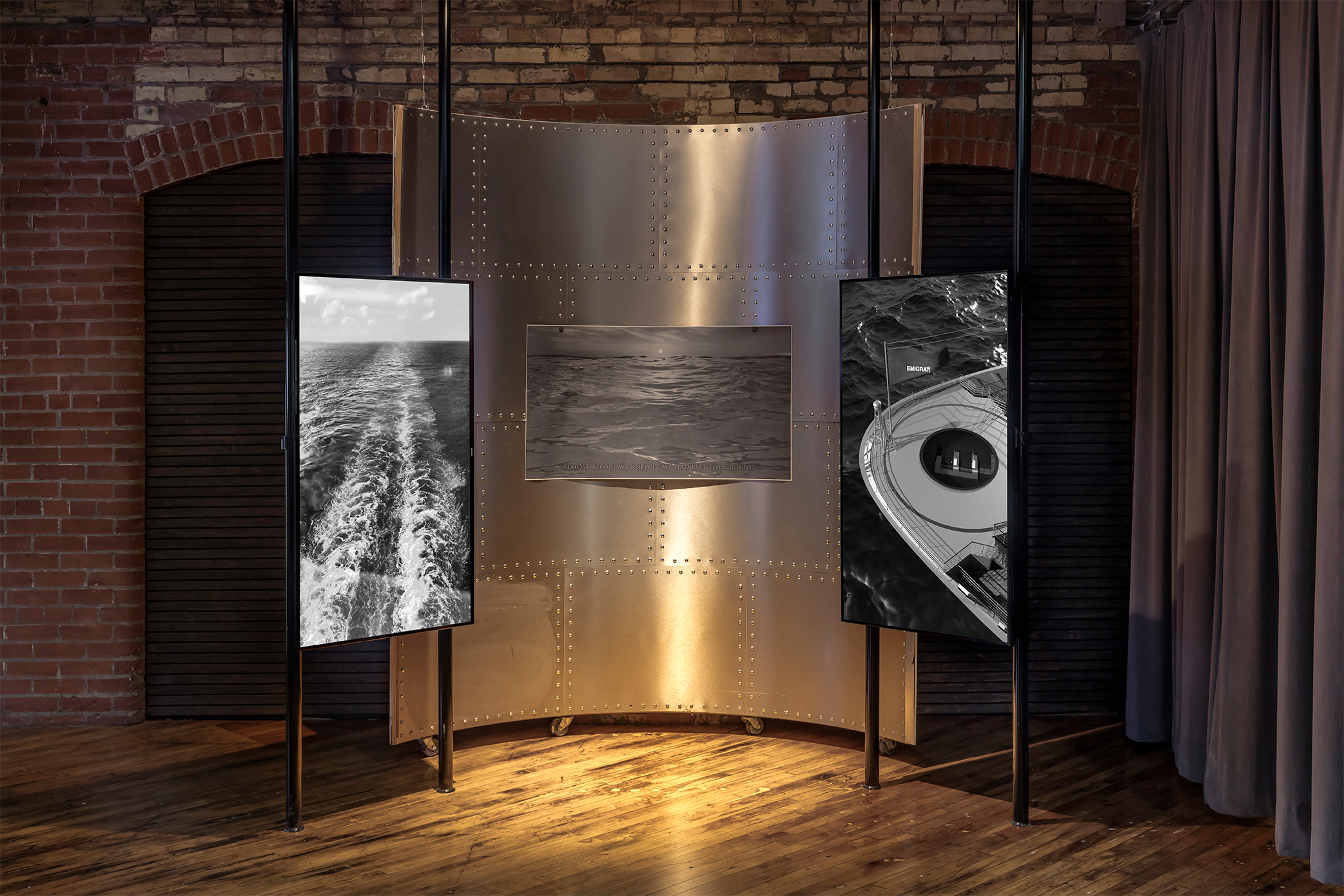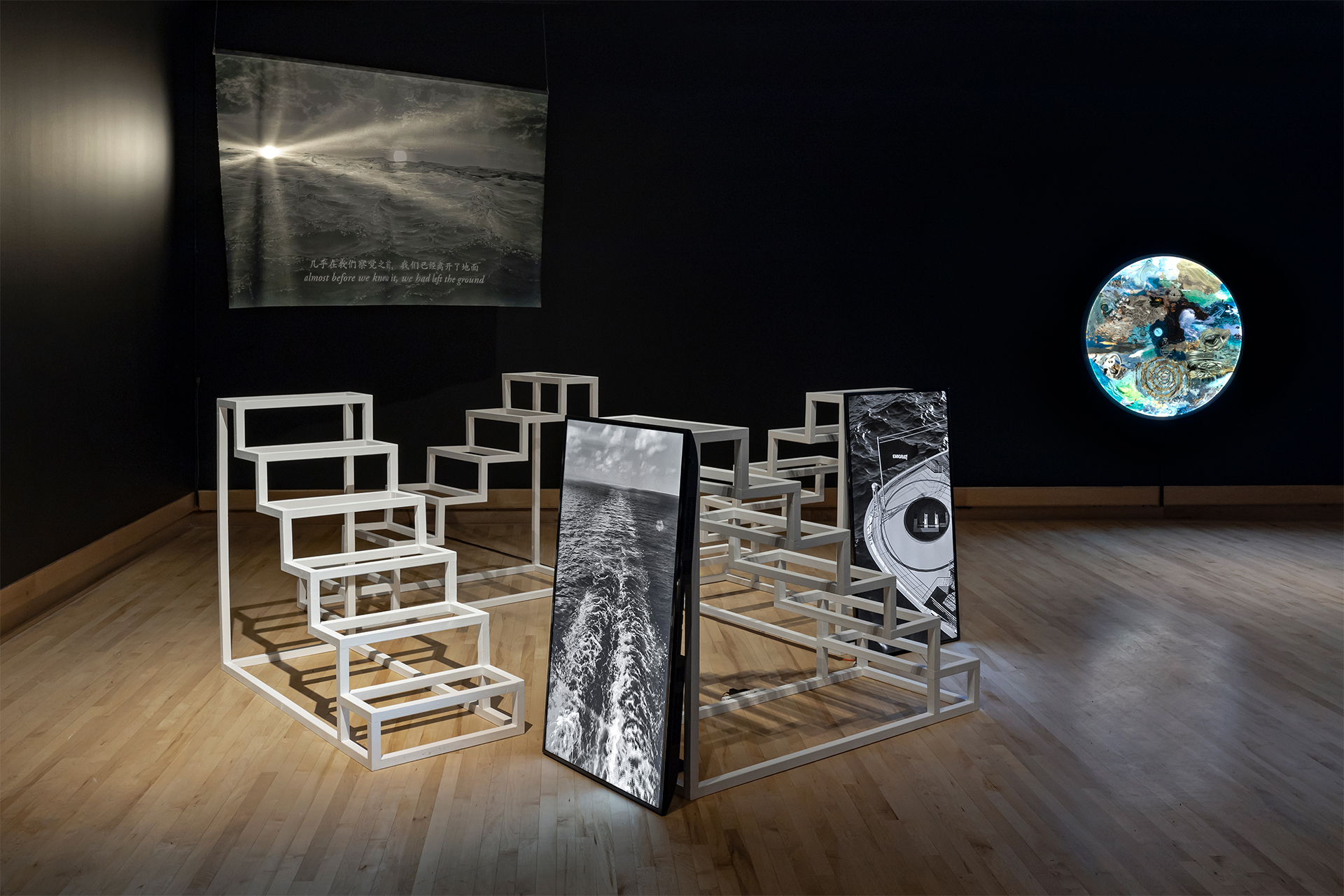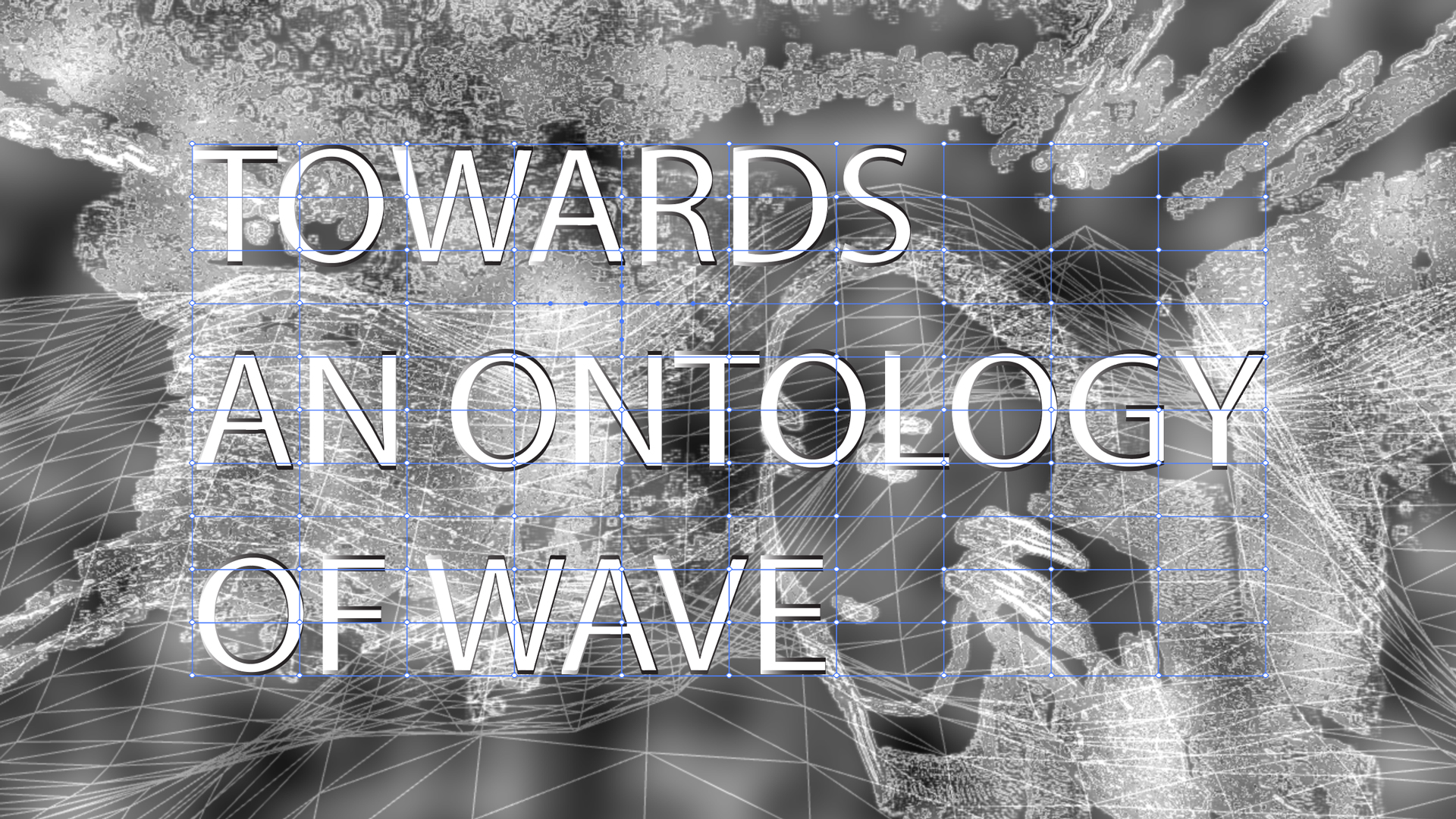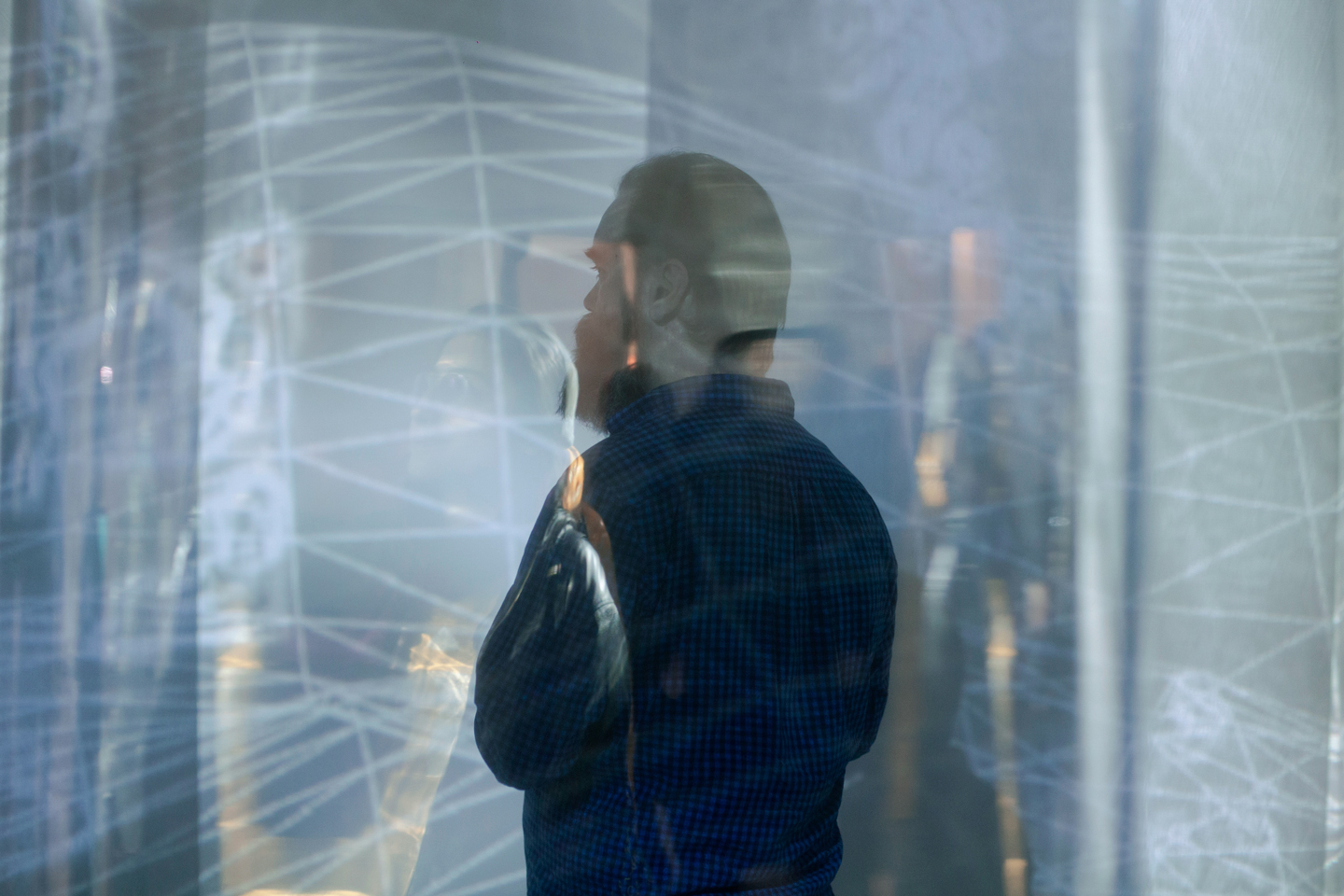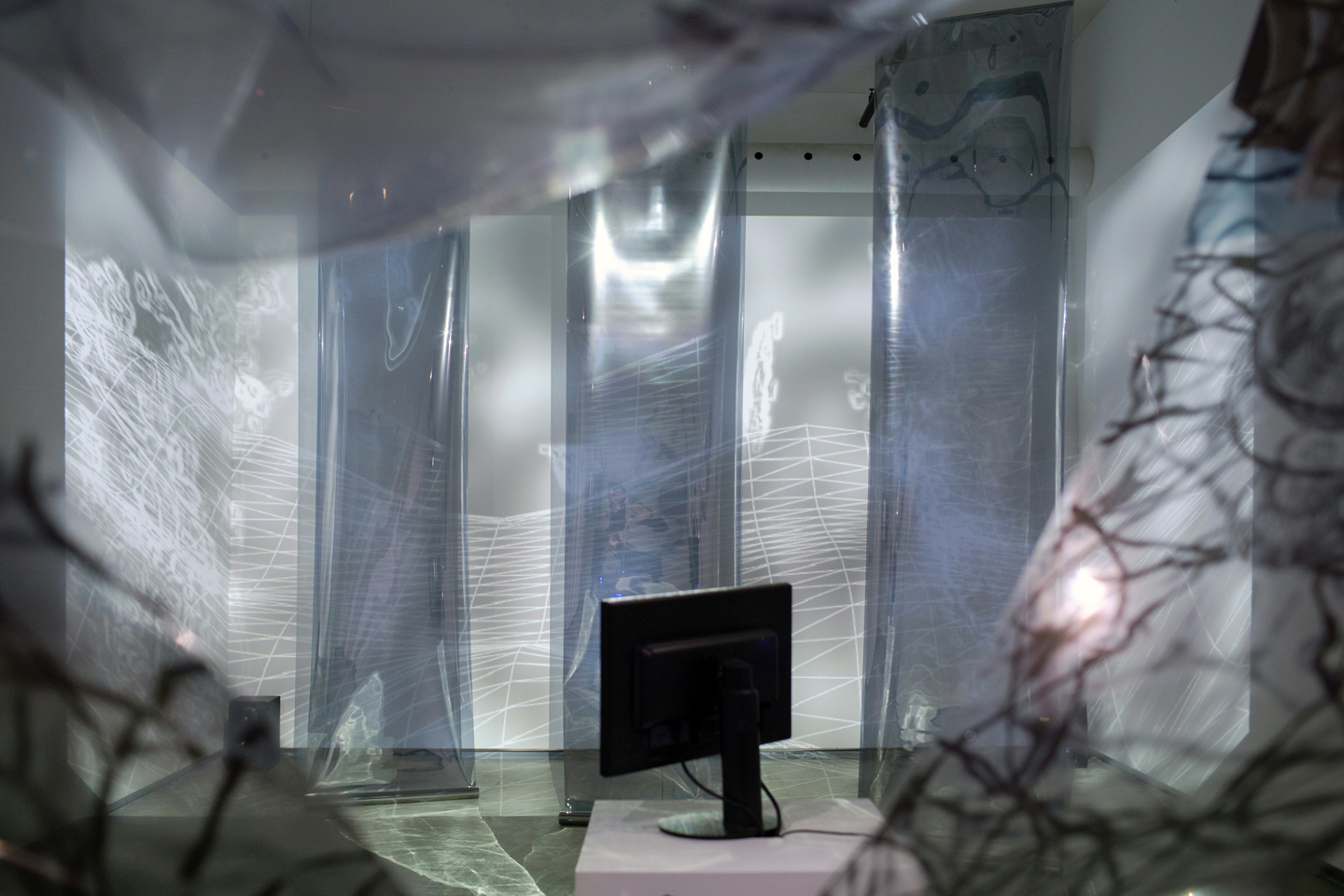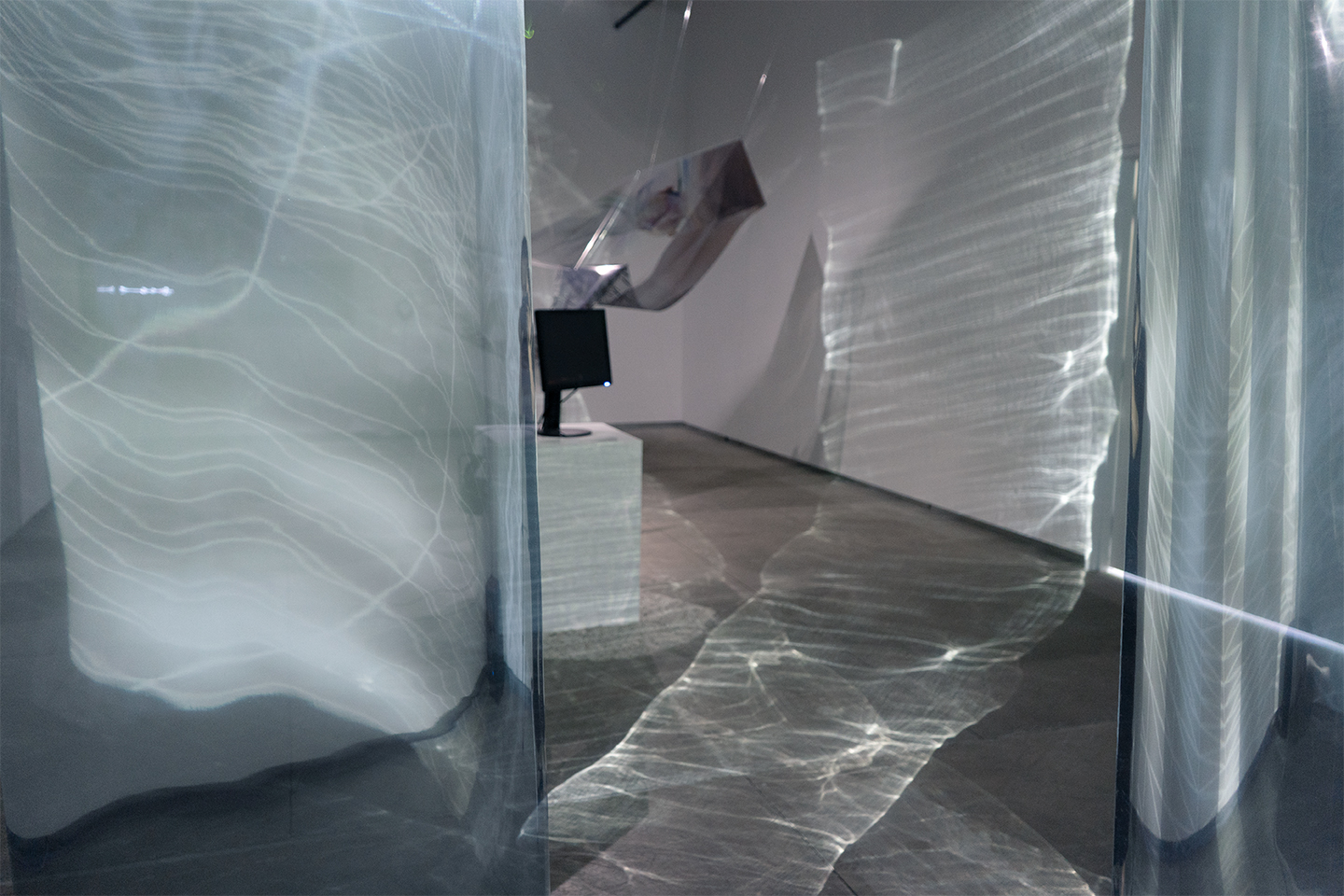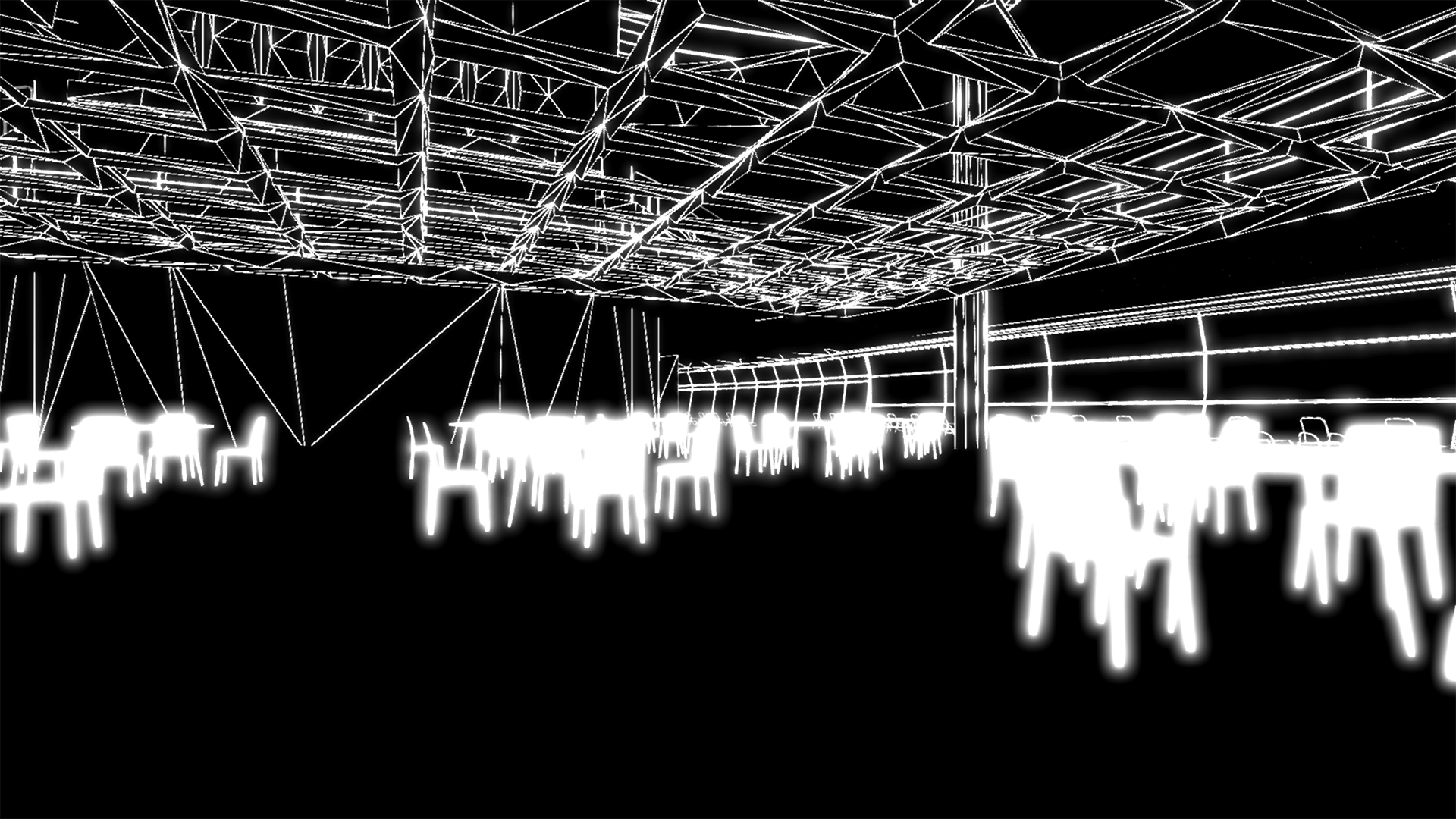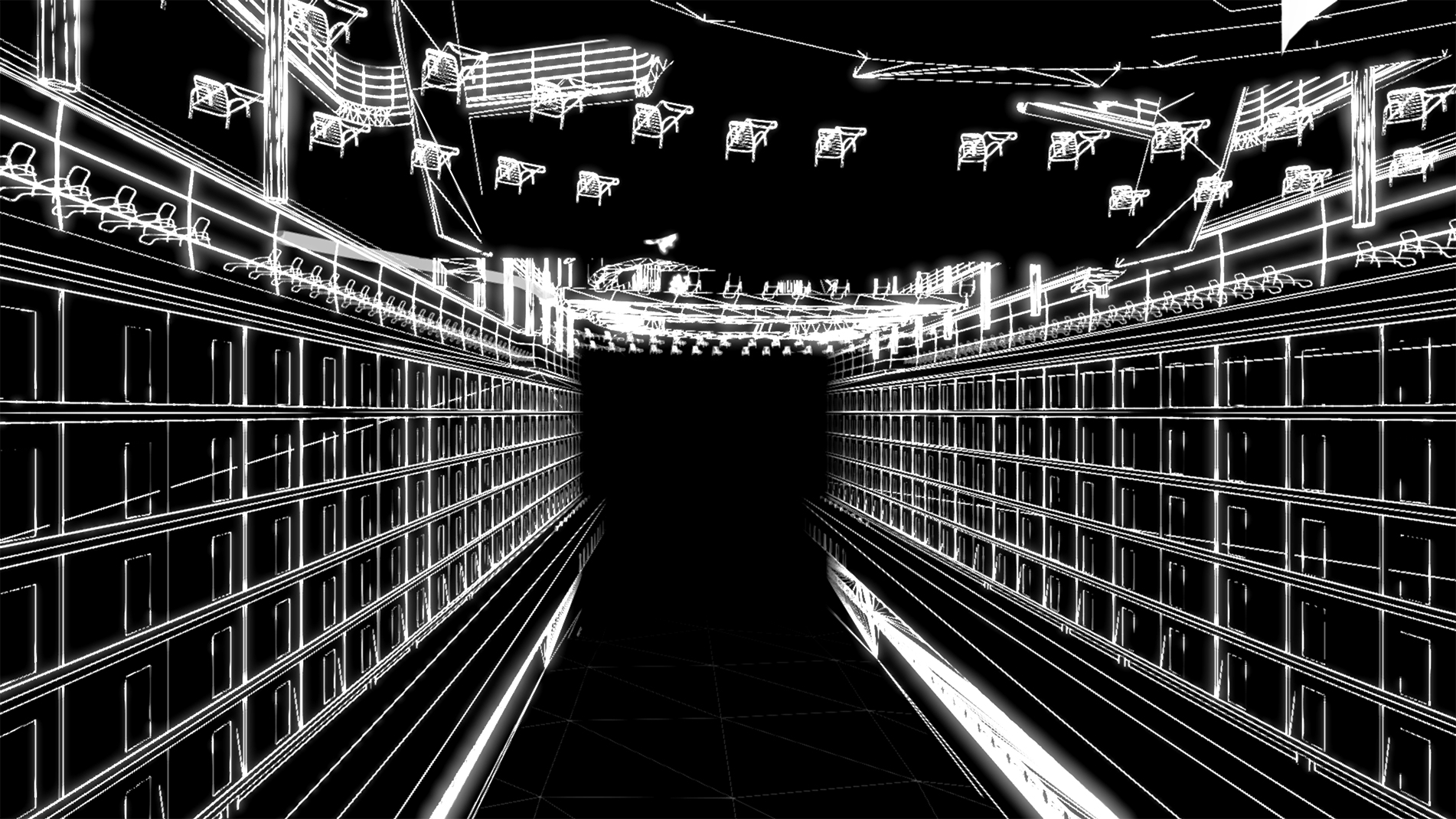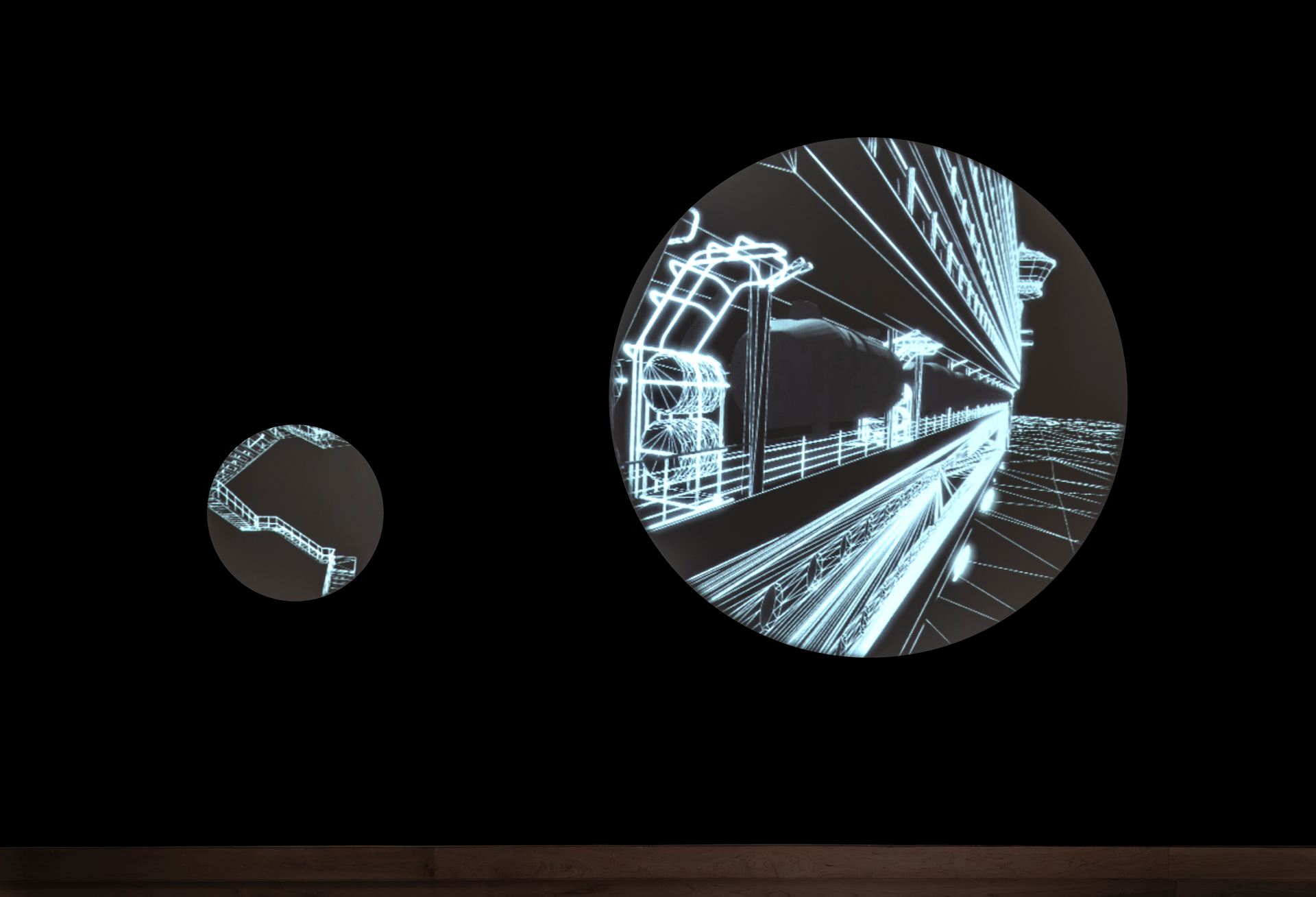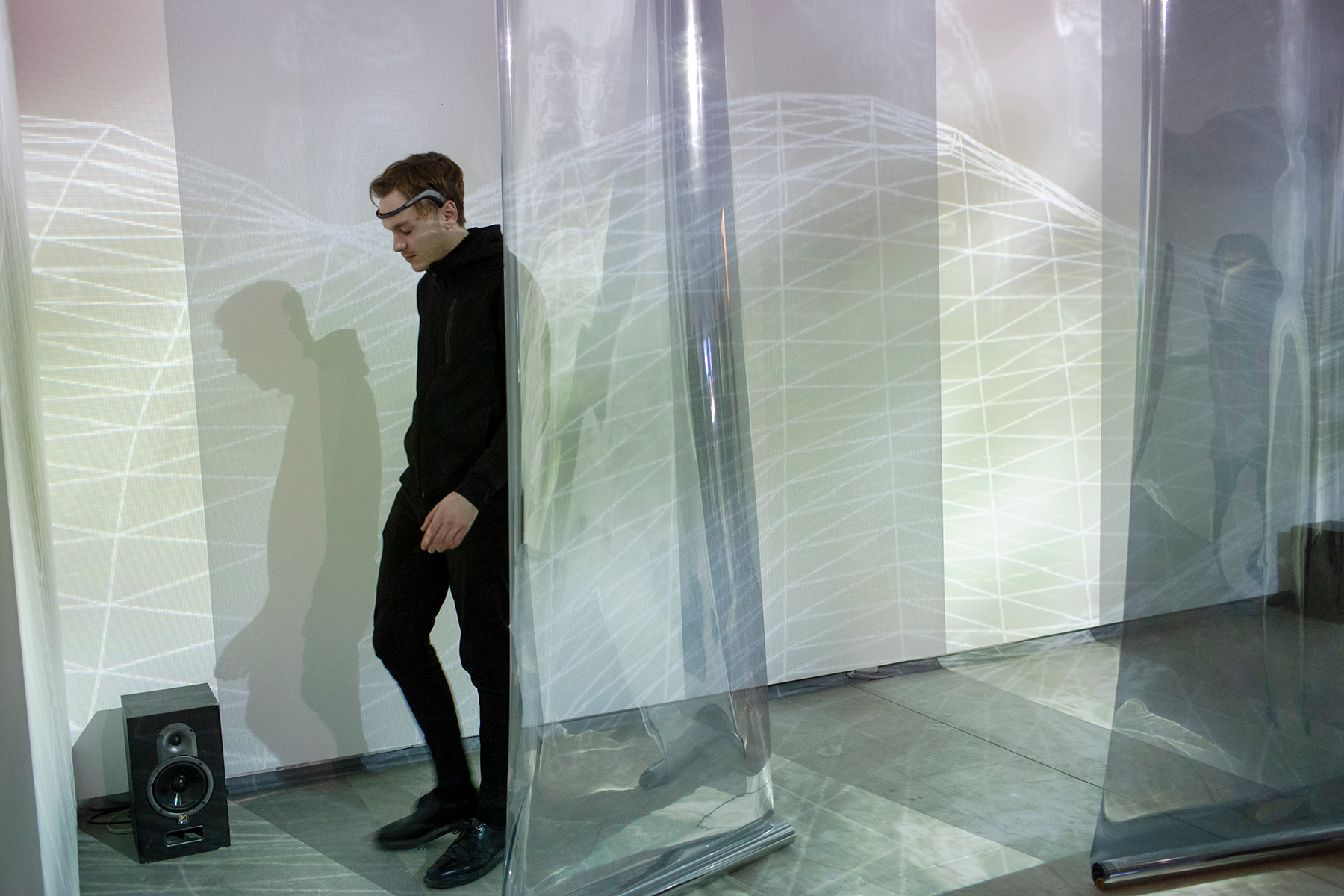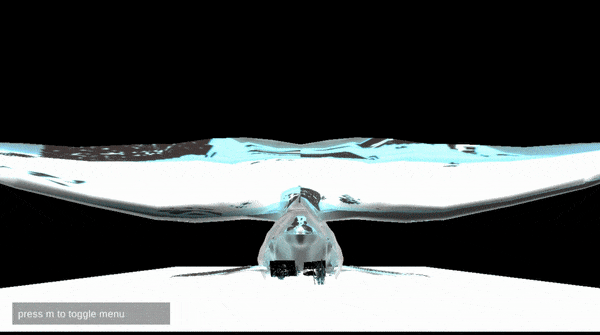The Spectacles Before Us Were Indeed Sublime
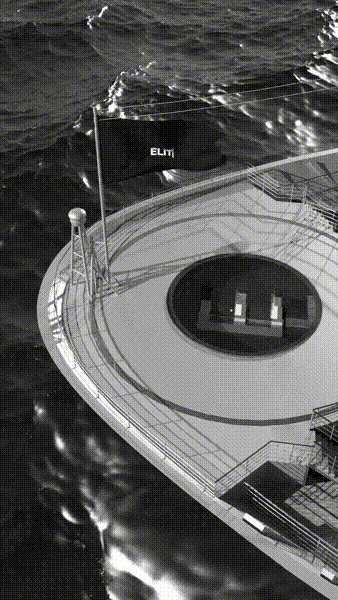
Coda 2018
dimension variable
two-channel 4K video (b/w, sound, loop), dye sublimation print on flag, light of warm shades, galvanized plano-concave structure / wooden Penrose staircases
Fig.2 installation view, The Stories That Tell Stories, Trinity Square Video, 2018. Photo by Toni Hafkenscheid
Fig.3 installation view, filling the Klein bottle (x) { (curated by Belinda Kwan), Varley Art Gallery of Markham, 2020. Photo by Toni Hafkenscheid
Coda, the passage that brings a movement to an end, marks the beginning of the series.
The first video channel shows the front deck and its ship flag announcing the various possible destinations — shuffling through words with connotations related to maritime travel. The second channel is the rear view of a moving ship. It depicts undulating water wakes, boundless ocean and the horizon.
The four staircases in the installation are a fragmented version of the Penrose stairs, a spatial model that violates the rules of Euclidean geometry. The illusion of ascending and descending on Penrose stairs is similar to the built-in staircases on cruise ships which appear identical and intentionally generate a sense of disorientation and confinement. As in a shopping mall, these architectural decisions are meant to be labyrinthine, encouraging the ongoing search for entertainment and consumable goods. Taking apart the Penrose stairs demystifies the incomprehensible geometry and symbolically disrupts the profit-driven design intentions of cruise ships.
In the background, hung in the air is a flag printed with a computer-generated image of the horizon. Warm shades shine through the horizon and the glistening surface of the fabric or the ocean, creating an illusionary puzzle— the sun in this simulated sky could be considered real or fake, rising or setting, and or in between.
Navigating the uncharted waters simulated by virtual time-space, the ship constitutes a perpetual attempt to leave the past behind. and move towards an uncertain future.
Every Body is Every Atom is Every Net is Every Wave 2019
Through an active webcam, this interactive installation mirrors an ever-changing metaverse that interweaves undulating cartographic grids with dissolving contours of somatic movement from its audience and surrounding architectural space. The present and the past collapse when the moving images are projected onto free hanging mirror film scrolls. Physical reflections of bodily data fill the space with transient lights and shadows — the biodigital imagery invoking the networked world, colonized by computation on a planetary-scale, and also the liquid impermanence of consciousness and self.
duration & dimension variable
kinetic interactive installation (webcam/Kinect, custom software system, mirror film scrolls)
Fig.5 installation view, All Hours (curated by Bojana Stancic), The Henry Moore Sculpture Centre, Art Gallery of Ontario, 2019.
Fig.6 & 7 & 8, installation view, filling the Klein bottle (y) { (curated by Belinda Kwan), InterAccess, 2020. Fig. 6 & 7 photo by Natalie Logan
Belly of the Whale 2019 – 2020
duration & dimension variable
virtual reality experience (VR headset and controller, in collaboration with Jonathan Carroll), real-time EEG sonification (brainwave sensing headset, surround sound, custom software system), salt
This project is supported by Toronto Arts Council. EEG headset is sponsored by MUSE thanks to Brendan Lehman.
Fig.13 installation view, filling the Klein bottle (x) { (curated by Belinda Kwan), Varley Art Gallery of Markham, 2020. Photo by Toni Hafkenscheid
Fig.14 & Fig.17 installation view, filling the Klein bottle (y) { (curated by Belinda Kwan), InterAccess, 2020. Photo by Natalie Logan
Belly of the Whale takes the first chapter as a point of departure for a first-person view virtual reality experience of cruising. On the ship, passengers’ geo-locations are tracked and stored as data streams. Traces of their navigational paths are visualized as ghostly specters, dynamically laid over time, visible in the next user’s VR experience. The micro-pathways of audience movements reflect the macro migration patterns and systemic structures of surveillance capitalism. An impossible staircase appears, using a generative algorithm to create new steps each time the user goes up or down, trapping them in a navigational loophole.
Fig.15 & Fig.16 diagrams for brainwave biofeedback
While the user experiences the VR scenes, the brainwave headband worn by themselves or their surrounding peers feeds a custom software with the ebb and flow of their brain wave signals. The brain wave data is then translated into ocean-like waves of pink noise, sweeping viewers and listeners into the proverbial ocean.
Overture 2019 – 2020
duration & dimension variable
data visualization of VR user paths (in collaboration with Jonathan Carroll)
Fig.19 screencap, filling the Klein bottle(z) { }}} (curated by Belinda Kwan), online game developed by Jonathan Carroll. featured exhibition of CONTACT Photography Festival, presented by Bunker 2 Contemporary Art Container, in partnership with Trinity Square Video, 2020.
The Spectacles Before Us Were Indeed Sublime depicts a fictional voyage on a cruise ship named E. Bending spacetime in a first-person view, Spectacles uses cruise imagery as a speculative vantage point for re-imagining the colonial past in the shared present, and gestures towards the cultural implications of maritime voyage as not only the starting point of modern global colonialism, but of segregated diaspora and migration more broadly. On the metaphysical level, Spectacles researches the ocean as an archetype of the unconscious that is in constant transmutation and translates the oceanic as tangible experiences channeling the planetary sensorium from a perspective that is towards an ontology of wave.
Related exhibition/text: filling the Klein bottle
